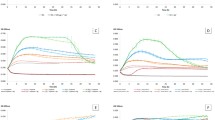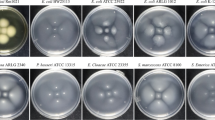Abstract
The susceptibility of Escherichia coli B to the antibacterial activity of silver ions was measured in terms of the initial inhibitory concentration, complete inhibitory concentration, postagent effect for bacteriostatic susceptibility, minimum bactericidal concentration, maximum tolerant concentration, and log killing time for bactericidal activity. At a concentration of 9.45 μM and an inoculum size of 10 CFU ml, silver caused growth delay of E. coli; at a concentration of 18.90 μM, silver completely inhibited bacterial growth. Prolonged postagent effects ranged between 1.5 and 12 h at 0.75 x the initial inhibitory concentration, 1.0 x the initial inhibitory concentration, and 1.5 x the initial inhibitory concentration of the silver ion. One log-unit of viable bacterial population size was lost every 30 min at the minimum bactericidal concentration of the silver ion. Silver tolerance was determined as 20 times the initial inhibitory concentration with 48 h of exposure. This study presents an evaluative model as a reference for the quantitative analysis of the susceptibility of bacteria to silver ions. © Rapid Science 1998.
Similar content being viewed by others
References
Bailey WR, Scott EG. 1974 Determination of susceptibility of bacteria to antimicrobial agents. In Bailey WR, Scott EG, eds. Diagnostic Microbiology. St Louis: The C.V. Mosby Co; 316-317.
Becker RO, Spadaro JA. 1978 Treatment of orthopaedic infections with electrically generated silver ions. J Bone and Joint Surg 60(A), 871-881.
Berger TJ, Spadaro JA, Chapin SE, Becker RO. 1976a Electrically generated silver ions: quantitative effects on bacterial and mammalian cells. Antimicrob Agents Chemother 9, 357-358.
Berger TJ, Spadaro JA, Bierman R, Chapin SE, Becker RO. 1976b. Antifungal properties of electrically generated metallic ions. Antimicrob Agents Chemother 10, 856-860.
Bhagava KB, Shirali GN, Abhyankar VS, Garde KC. 1992 Treatment of allergic and vasomotor rhinitis by the local application of different concentrations of silver nitrate. J Laryngol Otol 106, 699-701.
Deitch ED, Marino AA, Gillespie TE, Albright JA. 1983 Silver-nylon: a new antimicrobial agent. Antimicrob Agents Chemother 23, 356-359.
Ersek RA, Denton DR. 1988 Cross-linked silver-impregnated skin for burn wound management. J Burn Care Rehabil 9, 476-481.
Fifield FW, Kealey D. 1975 Principle and Practice of Analytical Chemistry. London: International Textbook Company Limited.
Fox CL, Jr 1968 Silver sulphadiazine: a new topical therapy for Pseudomonas in burns. Arch Surg 96, 184-188.
Gilman AG, Goodman LS, Gilman A. 1980 Goodman and Gilman's Pharmacological Basis of Therapeutics, 6th ed. New York: Macmillan Publishing Co.
Golubovich VN, Rabotnova IL. 1974 Kinetics of growth inhibition in Candida utilis by silver ions. Microbiol 43, 948-950.
Gottschalk G. 1988 Bacterial Metabolism. New York: Springer-Verlag.
Grier N. 1977 Silver and its compounds. In N. Grier, ed. Disinfection, Sterilization, and Preservation.Philadelphia: Lea & Febiger; 376-387.
Griffin PM, Tauxe RV. 1991 The epidemiology of infections caused by Escherichia coli 0157:H7, other enterohemorrhagic Escherichia coli and associated hemolytic uremic syndrome. Epidemiological Review 13, 60-98.
Hamilton-Miller JM, Shah S, Smith C. 1993 Silver sulphadiazine: a comprehensive in vitro reassessment. Chemotherapy 39, 405-409.
Handwerger S, Tomasz A. 1985 Antibiotic to tolerance among clinical isolates of bacteria. Rev Infect Dis 7, 368-386.
Joklik WK, Willett HP, Amos DB, Wilfert CM. 1988 Zinsser Microbiology, 19th edn. Connecticut: Appleton & Lange.
Long DM. 1972. Silver nitrate therapy as an adjunct in the treatment of myelomeningocele. J Neurosurg 36, 769-772.
MacKeen PC, Person S, Warner SC, Snipes W, Stevens SE, Jr 1987 Silver-coated nylon fiber as an antibacterial agent. Antimicrob Agents Chemother 31, 93-99.
Modak SM, Fox CL, Jr 1973 Binding of silver sulfadiazine to the cellular components of Pseudomonas aeruginosa. Biochem Pharmacol 22, 2391-2404.
Moing G, Thunus L, Dauphin JF, Depy-Dupont G, Deby C. 1990 Anti-inflammatory properties of a preparation containing low doses of copper, gold and silver. Int J Tissue React 12, 251-262.
Odenholt-Tornqvist I.E, Lowdin E, Cars O. 1992 iPost-antibiotic sub-MIC effects of vancomycin, roxithromycin, sparfloxacin, and amikacin Antimicrob Agents Chemother 36, 1852-1858.
Sabath LD, Wheeler N, Laverdiere M, Blazevic D, Wilkinson BJ. 1977 A new type of penicillin resistance of Staphylococcus aureus. Lancet 1, 443-447.
Slawson RM, Lee H, Trevors JT. 1990. Bacterial interactions with silver. Biol Metals 3, 151-154.
Thibodeau EA, Handelman SL, Marquis RE. 1978 Inhibition and killing of oral bacteria by silver ions generated with low density direct current. J Dent Res 57, 922-926.
Zhanel GG, Karlowsky JA, Davidson RJ, Hoban DJ. 1992 Effect of pooled human cerebrospinal fluid on the postantibiotic effects of cefotaxime, ciprofloxacin, and gentamicin against Escherichia coli. Antimicrob Agents Chemother 36, 1136-1139.
Author information
Authors and Affiliations
Rights and permissions
About this article
Cite this article
Zhao, G., Stevens, S.E. Multiple parameters for the comprehensive evaluation of the susceptibility of Escherichia coli to the silver ion. Biometals 11, 27–32 (1998). https://doi.org/10.1023/A:1009253223055
Issue Date:
DOI: https://doi.org/10.1023/A:1009253223055




